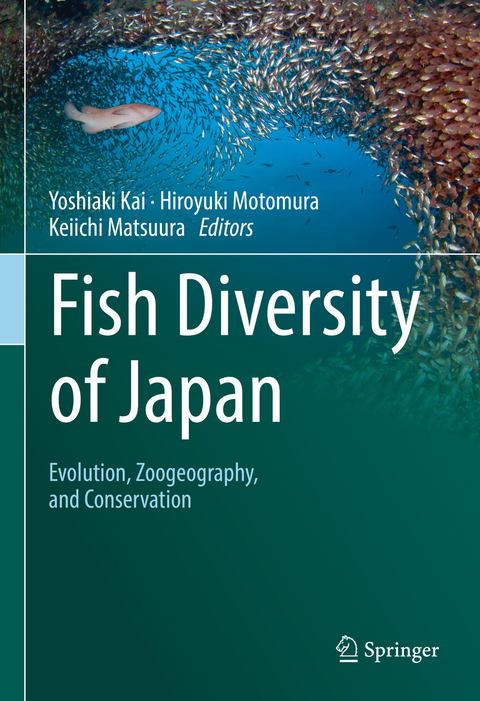
Fish Diversity of Japan
Springer Verlag, Singapore
978-981-16-7426-6 (ISBN)
The Japanese Archipelago is surrounded by two major warm and one cold currents. It is located in the western North Pacific and encompasses several climatic regimes from north to south. Although the land area of Japan is small, the Exclusive Economic Zone (EEZ) of Japan ranks as the sixth largest in the world, including several marginal seas (Sea of Okhotsk, Sea of Japan, and East China Sea), and deep trenches (Izu-Ogasawara, Japan, and Kurile Trenches). Owing to a variety of marine habitats and a complex geological history, Japan has a rich fish species diversity, representing over 4,500 species in 370 families.
The richness of fish species diversity has attracted many scientists since the late 1700s, and continuous studies have led to the development of ichthyology in Japan. With chapters written by leading experts in the field, the book will provide a stimulating and reliable resource for future research and contribute to the progress of ichthyology of the world.
Yoshiaki Kai Kyoto University, Doctor of Agriculture Hiroyuki Motomura Kagoshima University, Doctor of Agriculture Keiichi Matsuura National Museum of Nature and Science, Doctor of Fisheries
1. Introduction.- I. Fish Diversity and Ichthyology of Japan.- 2. Geography, Currents, and Fish Diversity of Japan.- 3. Origins and Present Distribution of Fishes in Japan.- 4. Ichthyology and Collection Building in Japan.- II. Habitat Distribution and Species Diversity.- 5. Fish Diversity along the Kuroshio Current.- 6. What Is Known of Fish Diversity in the Sea of Japan? Flatfishes – a Case Study.- 7. Fish Diversity of Subarctic Waters in Japan.- 8. Diversity and Distribution Patterns of Deep-Sea Demersal Fishes of Japan: a Perspective from Grenadiers.- 9. Fish Diversity of Estuaries Revealed by Environmental DNA.- III. Diversity within Species: Phylogeographic Perspective on Japanese Fishes.- 10. Deep-sea Fishes.- 11. Phylogeography of Coastal Fishes of Japan.- 12. Lake Biwa and the Phylogeography of Freshwater Fishes in Japan.- IV. Morphological and Ecological Diversifications.- 13.Migration of Fishes in Japan.- 14. Adaptive Phenotypic Divergence in Fishes of Japan: Potential Model Systems for Ecological and Evolutionary Genomics.- 15. Ecological Diversity of Larval Fishes –– Ontogeny of Deep-sea Demersal Species.- 16. Morphological Diversity of the Lateral Line System in Teleostei.- 17. Distributional Shifts and Hybridization in Marine Fishes of Japan.- V. Conservation of Fish Diversity in Japan.- 18. Coastal Fishes in Sandy Beaches.- 19. Coastal Fishes in Rocky and Coral Reefs.- 20. Fishes in Seagrass Habitats.- 21. Coastal Fishes in Mangroves.- 22. Coastal Fishes in Tidal Flats and Salt Marshes.- 23. Conservation of Freshwater Fish Diversity in Japan.- 24. Using Gyotaku to Reveal Past Records of Fishes Including Extinct Populations.- 25. Convention on Biological Diversity and its Impact on Research, with Special Reference to Ichthyology.
| Erscheinungsdatum | 28.01.2022 |
|---|---|
| Zusatzinfo | 1 Illustrations, black and white; VI, 454 p. 1 illus. |
| Verlagsort | Singapore |
| Sprache | englisch |
| Maße | 178 x 254 mm |
| Themenwelt | Naturwissenschaften ► Biologie ► Evolution |
| Naturwissenschaften ► Biologie ► Ökologie / Naturschutz | |
| Naturwissenschaften ► Biologie ► Zoologie | |
| Schlagworte | conservation • Distribution • Ecology • Ichthyofauna • Ichthyology • Morphology • Natural History • phylogeography • Red List |
| ISBN-10 | 981-16-7426-4 / 9811674264 |
| ISBN-13 | 978-981-16-7426-6 / 9789811674266 |
| Zustand | Neuware |
| Haben Sie eine Frage zum Produkt? |
aus dem Bereich


